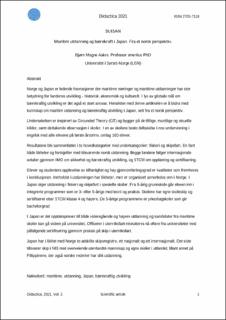| dc.description.abstract | Norway and Japan are leading maritime nations where maritime industries and maritime education are of great importance for the countries' development - historically, economically and culturally. In light of global goals of sustainable development, there is also a great responsibility. The purpose of this article is to contribute knowledge about maritime education and sustainable development in Japan, seen from a Norwegian perspective.
The study is inspired by Grounded Theory (GT) and is based on written, oral and visual sources, as well as participatory observation in schools. In one of the schools, participation also consisted of some teaching in English with all the students in the first year, about 160 students.
The results were summarized in two main categories with subcategories: fishing- and maritime technology. One found both similarities and differences with similar Norwegian education. Both countries follow international agreements through the IMO on security and sustainable development, and the STCW on training and certification. However, the way of management is different.
Students sense of belonging and high completion rate are some of the qualities. The content of the education has similarities, but is organized differently than in Norway. In Japan, maritime education takes place in special schools. After 9-year primary school, the student enters integrated 3- or 5-year programs with theory and practice. The schools have their own ships and certify according to STCW class 4 and higher. The 5-year programs are polytechnics that provide a associate bachelor's degree.
In Japan, there are entrance exams for both upper secondary and higher education, and graduates from maritime schools can go on to university. Officers in foreign trade are now more often recruited from universities with subsequent certification through practice on ships in foreign trade.
Like Norway, Japan has two separate ship registers, one national and one international. The latter corresponds to ships in NIS with predominantly foreign crews and their own schools abroad, including in the Philippines, where Norwegian shipping companies also have such training. | en_US |
